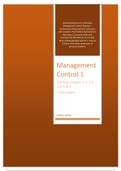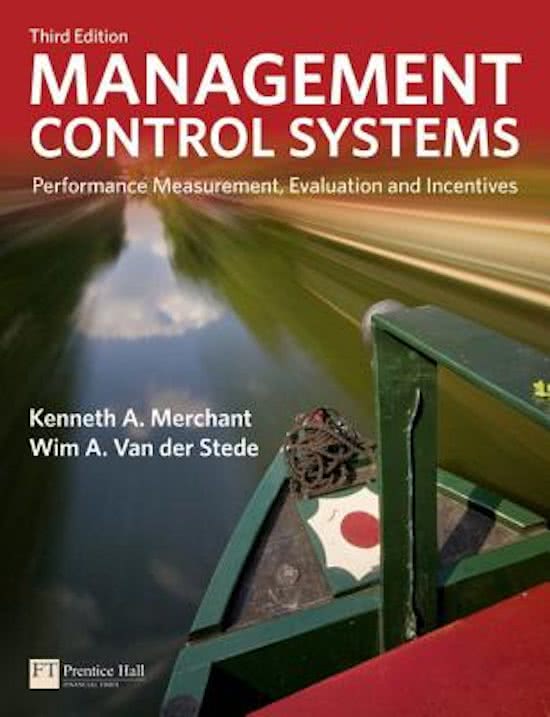Summary based on (1) the book
Management Control Systems –
Performance Measurement, Evaluation
and Incentive. Third Edition by Kenneth A.
Merchant. (2) Lecture slides and
comments by the lecturer, B. van den
Berg, of Management Control 1. And (3)
Extracts from other summaries of
previous students.
Management
Control 1
Summary Chapters 1, 2, 3, 4,
5, 6, 7, 8, 9
+ Trials Exams
Kathleen Gaillot
,Table of Contents
Chapter 1: Management and Control ..................................................................................................... 1
1.1 Causes of Management Control Problems ................................................................................... 2
1.2 Characteristics of Good Management Control ............................................................................. 2
1.3 Control Problem Avoidance .......................................................................................................... 3
1.4 Control Alternatives ...................................................................................................................... 3
Chapter 2: Results Controls .................................................................................................................... 5
2.1 Prevalence of Results Controls ..................................................................................................... 5
2.2 Results Controls and the Control Problems .................................................................................. 5
2.3 Elements of Results Controls ........................................................................................................ 6
2.3.1 Defining Performance Dimensions ........................................................................................ 6
2.3.2 Measuring Performance ........................................................................................................ 7
2.3.3 Setting Performance Targets ................................................................................................. 7
2.3.4 Providing Rewards ................................................................................................................. 7
2.4 Conditions Determining the Effectiveness of Results Controls .................................................... 7
Chapter 3: Action, Personnel and Cultural Controls ............................................................................... 8
3.1 Action Controls.............................................................................................................................. 8
3.2 Action Controls and the Control Problems ................................................................................... 8
3.3 Prevention Versus Detection ........................................................................................................ 9
3.4 Conditions Determining the Effectiveness of Action Controls ..................................................... 9
3.5 Personnel Controls ...................................................................................................................... 10
3.6 Cultural Controls ......................................................................................................................... 10
3.7 Personnel/Cultural Controls and the Control Problems ............................................................. 11
3.8 Effectiveness of Personnel/Cultural Controls ............................................................................. 11
Chapter 4: Control System Tightness .................................................................................................... 12
4.1 Tight Results Control ................................................................................................................... 12
4.2 Tight Action Controls .................................................................................................................. 13
4.3 Tight Personnel/Cultural Controls .............................................................................................. 13
Chapter 5: Control System Costs .......................................................................................................... 15
5.1 Direct Costs ................................................................................................................................. 15
5.2 Indirect Costs .............................................................................................................................. 15
Chapter 6: Designing and Evaluating Management Control Systems .................................................. 17
6.1 What is desired? and What is likely? .......................................................................................... 17
6.2 Choice of Controls ....................................................................................................................... 17
6.3 Choice of Control Tightness ........................................................................................................ 19
Chapter 7: Financial Responsibility Centres .......................................................................................... 21
7.1 Advantages of Financial Results Control Systems ....................................................................... 21
7.2 Types of Financial Responsibility Centres ................................................................................... 21
7.2.1 Variations ............................................................................................................................. 23
7.3 Choice of Financial Responsibility Centres ................................................................................. 24
7.4 The Transfer Pricing Problem ...................................................................................................... 25
7.4.1 Purposes of Transfer Pricing ................................................................................................ 26
7.4.2 Transfer Pricing Types .......................................................................................................... 26
Chapter 8: Planning and Budgeting ...................................................................................................... 28
8.1 Purposes of Planning and Budgeting .......................................................................................... 28
8.2 Planning Cycles............................................................................................................................ 28
8.3 Target Setting .............................................................................................................................. 29
8.4 Planning and Budgeting Practices, and Criticisms ...................................................................... 31
,Chapter 9: Incentive Systems................................................................................................................ 32
9.1 Purpose of Incentives .................................................................................................................. 32
9.2 Monetary Incentives ................................................................................................................... 32
9.3 Incentive System Design ............................................................................................................. 33
9.4 Criteria for Evaluating Incentive Systems ................................................................................... 34
9.5 Group Reward ............................................................................................................................. 34
9.6 Conclusion ................................................................................................................................... 34
Trial Exams ............................................................................................................................................ 35
Arcadis Case ...................................................................................................................................... 35
Rollepaal Case ................................................................................................................................... 39
IKEA Case ........................................................................................................................................... 43
IKEA is facing huge problems in India ........................................................................................... 43
TenCate Case..................................................................................................................................... 48
Prezzo Case ....................................................................................................................................... 54
Note: Text in green is information taken from the book (not on the lecture slides)
Yellow stars are attributed to content deemed more important to study for the exam.
Orange stars indicate material that should be understood – also important.
Lectures / Tasks Schedule: Semester -2019 Q3
Week Chapter(s) Case
1 1 Triodos Bank (on Blackboard)
2 2, 3 Houston Fearless 76 (Ch 2)
3 4 Starbucks (on Blackboard)
4 5 Better Beauty, Inc (Ch 5)
5 6 Game Shop, Inc (Ch 6)
6 7 Kranworth Chair Corp. (Ch 7)
7 8, 9 Rollepaal (on Blackboard)
1 10 Berkshire Industries PLC
2 13 Pacific Sunwear
3 14 Don Russel
4 15 Lernhout & Hauspie
5 Risk Management Entropic Comm, Inc (Ch 13)
6 Case studies Airbnb
7 Summary & exam training
Chapter 1: Management and Chapter 3: Action, Personnel
Chapter 2: Results Controls
Control and Cultural Controls
Chapter 6: Designing and
Chapter 4: Control System Chapter 5: Control System
Evaluating Management
Tightness Costs
Control Systems
Chapter 7: Financial Chapter 8: Planning and
Chapter 9: Incentive Systems
Responsibility Centres Budgeting
Trials: Exam practice
, Chapter 1: Management and
Control
Chapter 1: Management and Control
Management Control: All the devices and systems managers use to ensure that the behaviour and decisions
of employees are consistent with the organization’s objectives and strategies
• Management control is to get strategy working • Management control is using information
• Management control is about risks • Management control is about human behaviour
Management control failures can lead to: Strategic controls observe external factors,
- Large financial losses while management control look at it internally.
- Reputation damage ---------------------------------------------------------------
- Organizational failure Proactive controls (which prevent problems
Good management control systems (MCSs) can address before the organization suffers any adverse
problems like thefts, frauds, and unintentional errors. effects on performance), are better than
Proactive Controls: controls that are designed to reactive controls.
prevent problems before the organization suffers.
- Planning processes
- Require expenditure approvals
- Segregation of duties
- Restricted access
Benefit of management control: increased probability that the organization´s objectives will be achieved
Management: The processes of organizing resources and directing activities for the purpose of achieving
organizational objectives. Breaking down the Broad Area of Management into Smaller Elements ↓
Functions Resources Processes
Product (or service) development People Objective setting
Operations Money Strategy Formulation
Marketing/Sales Machines Management Control
Finance Information ↑(execution/implementation)
The Management Process
1. Objective Setting 2. Strategy Formulation 3. Management Control
WHAT do we want to accomplish → HOW to use the resources → Execution
Become marketleader, produce the Product, markets, competitive Are our employees likely
safest car, find a cure for cancer advantage to behave appropriately?
1. Objective Setting
a. Knowledge of objectives is a prerequisite for the design of any MSC
b. Employees must have a basic understanding of what the organisation is trying to accomplish
c. Organizations should have a clear vision, that can be communicated easily to everyone
→ basis for setting clear objectives and targets Strategy
2. Strategy Formulation
a. Strategies define how organizations should use their resources to meet their objectives
b. Well-defined strategy guides employees in successfully pursuing their organizations objectives
→ conveys to employees what they are supposed to be doing
c. Many organizations develop strategies through systematic planning processes → intended strategy
d. For the purpose of designing MCSs, it is useful to have strategies that are as specific and detailed
as possible, if those strategies can be kept current
3. Management Control Versus Strategic Control
a. Strategic control = managers asking the question: Is our strategy valid, how should it be changed?
1
, Chapter 1: Management and
Control
b. Management control focuses on execution, and it involves addressing the general question: Are
our employees likely to behave appropriately? → Can be decomposed into several parts.
Management controls are about influencing human behaviour:
• Do employees understand what is expected of them?
• Will employees do what we expect of them? pursue the org´s objectives in line with strategy
• Are employees capable of doing a good job?
o If the answer to any of these questions is negative, what can be done to solve the
management control problems?
c. Managers addressing strategic control issues have a primarily external focus: examine the industry
and their organizations place in it
d. Managers addressing management control issues have a primarily internal focus: they reflect how
they can influence employees behaviours in desired ways
1.1 Causes of Management Control Problems
(Causes of) Management Control Problems:
1. Lack of Direction (telling the employee how they can contribute to the fulfilment of organizational
objectives)
2. Motivational Problems (naturally, organizational and individual objectives do not coincide –
individuals are self-interested. Such as finding ways to do a job as slowly as possible while appearing
to deliver enough.
a. Gamesmanship (making results appear better than they are, i.e. good performance reports.
b. Negative/dysfunctional behaviour
c. Falsifying information (etc.)
3. Personal Limitations (even motivated employees that want to perform may be unable to…)
a. Knowledge (i.e. lack of training)
b. Experience (i.e. limited ability to perceive new problems)
c. Character (i.e. ability to process information)
Influencing Human Behaviour:
More management control does not guarantee better control. - Do the salesmen understand what is
Having too much paperwork for a simple process might push expected of them?
the employee to find a workaround. Paired with a lack of a - Are they motivated to do what is
culture of responsibility, too much MCSs (management control expected of them?
systems) can push the employee to do wrong. - Are they capable of doing what is
expected?
1.2 Characteristics of Good Management Control
Good control means that management can be reasonably confident that no major unpleasant surprises will
occur. *perfect control does not exist.
The label out of control is used to describe a situation where there is a high probability of poor performance,
either overall or in a specific performance area, despite having a sound strategy in place.
The cost of not having a perfect control system is called a control loss. It is the different between the
theoretically possible performance given the strategy selected, and the performance that can be reasonably
expected only if the benefits by which they would reduce the control loss exceed the costs.
Optimal control can be said to have been achieved if the control losses are expected to be smaller than the
cost of implementing more controls. The benchmark is adequate control, not perfect control.
Good control should be assessed in a way that is future-oriented [have no unpleasant surprises in the future]
and objectives-driven [because the objectives represent what the organization seeks to attain].
2





